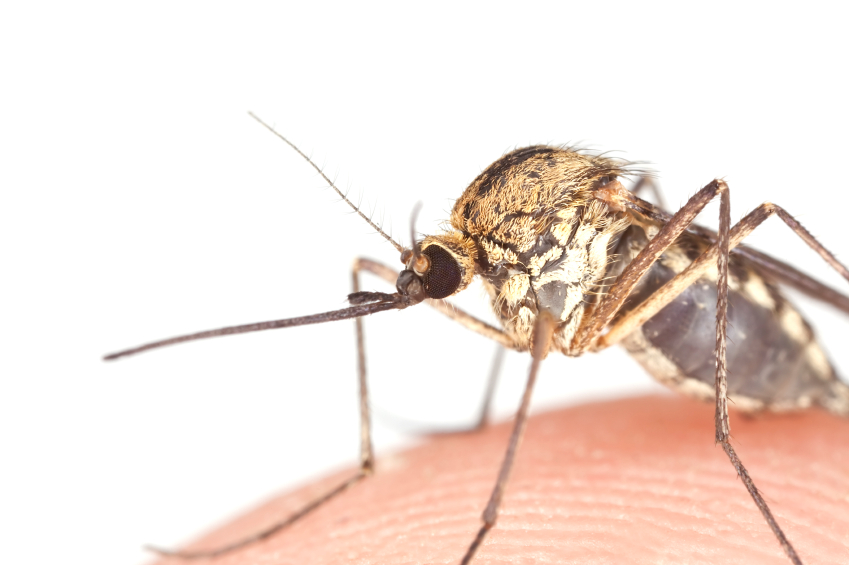Heartworms are one of the most deadly parasites of dogs and cats. Is your pet at risk? The answer is a resounding YES. It doesn’t matter whether you own an all indoor cat or a dog who likes to romp in the woods. All dogs and cats in the mid-Atlantic region are at risk for heartworm disease.
 Heartworms are carried by several species of mosquitos and are transmitted when the mosquito feeds. When a bite occurs, the larval heartworms migrate through the soft tissue to the blood vessels and then they travel to the heart and lungs. Once there, they mature into adult worms, sometimes reaching several inches in length. The adult worms then reproduce, sending offspring into the bloodstream. The next mosquito that bites ingests the larva, becoming infected and carrying the parasite to its next host.
Heartworms are carried by several species of mosquitos and are transmitted when the mosquito feeds. When a bite occurs, the larval heartworms migrate through the soft tissue to the blood vessels and then they travel to the heart and lungs. Once there, they mature into adult worms, sometimes reaching several inches in length. The adult worms then reproduce, sending offspring into the bloodstream. The next mosquito that bites ingests the larva, becoming infected and carrying the parasite to its next host.
The classic form of heartworm disease occurs in dogs and is easily diagnosed with a blood test. Dogs with the disease often have large numbers of adult worms living in the blood vessels of the lungs and in the heart. These worms partially block the flow of blood, acting like a dam in the vessels. When the dog is active, it may have trouble moving enough blood to bring oxygen to the tissues. The heart must work much harder than normal to move the same amount of blood, and over time this leads to heart disease. Additionally, when adult heartworms are a few years old, they die of old age. Dead worms cause significant inflammation in the surrounding lung tissue, leading to coughing and shortness of breath. As the disease progresses, poor oxygenation and advancing heart failure can lead to the death of the dog.
Cats are not the normal host for heartworms, but recent studies show that they are infected at nearly the same rate as dogs. Cats also contract the disease through the bite of an infected mosquito. The heartworms start their migration through the tissue and blood vessels to the lungs, but often die in the lungs before reaching full maturity. If adult heartworms develop in a cat, it is usually in low numbers. Despite this fact, the migration of larval worms through the lungs can cause severe and permanent damage. Studies have shown that infected cats, even those in which the worms die before reaching maturity, develop long-term inflammation and narrowing of the airways. These cats may cough, show shortness of breath, or die suddenly due to their disease. Feline heartworm disease mimics, and is often misdiagnosed, as asthma. This is because the clinical signs and radiographic findings are identical, and heartworm tests do not consistently identify infected cats.
Dogs who contract heartworm disease can be treated with injectable medications. The treatment is expensive and painful, and even when the worms are gone, the lungs may be permanently scarred. To date, a safe treatment has not been developed for cats. The best “treatment” for both dogs and cats is to prevent the disease all together. Monthly heartworm prevention medications are available for both dogs and cats through your veterinarian. These preventatives are inexpensive, effective, and safe. All dogs and cats should receive monthly preventatives, even those who never go outside. This is because mosquitos commonly invade houses. Studies have shown that all indoor cats are at nearly equal risk for heartworm infection as cats that spend time outdoors. Additionally, monthly preventatives should be continued year-round because some species of mosquitos that transmit heartworm disease are hardy even in the middle of winter when there are sub-freezing temperatures.
In the Northern Virginia area, heartworm infection rates (as measured in dogs, where the test can accurately detect infection) are higher than they have been in the last 10 years. Your pet doesn’t have to be one of those infected. Protect your pet year-round with a heartworm preventative every 30 days. For more information on heartworm disease, visit The American Heartworm Society.


Leave A Comment